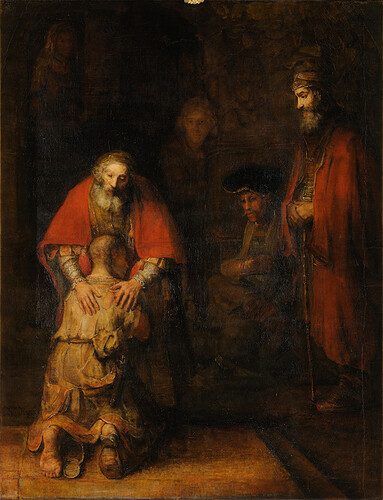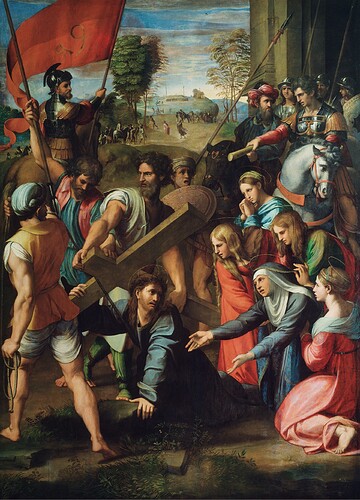In ‘The Bruised Reed’ by Richard Sibbes, I find a beautiful understanding of God’s mercy towards mankind. Sibbes published this work in 1630, and provides a refreshing look at what Christ has done for the sinner as he examines what Isaiah prophesied about the Messiah in Isaiah 42:1-3, “A bruised reed shall he not break, and the smoking flax shall he not quench: he shall bring forth judgement unto truth”. Whilst reading this book, I happened to visit an art gallery, where I saw the scene called ‘The Expulsion of Adam and Eve’ by Arthur Trevethin Nowell (1897). This painting impacted me greatly as I pondered on Sibbes’ work and I wanted to share a few thoughts on it.
In this oil on canvas scene, the figure of Eve in particular moved me, because of the sheer helplessness and shame with which she seems to be walking away, banished, from Eden. There was something about her posture that connected with my own past recognition of sin in my life – her head cowed towards Adam, and the need to be led out by another’s hand because of the weight of shame. Even her copious head of hair doesn’t cover her shame, as portrayed by her nakedness. Behind them are depicted four angels blocking their re-entry into Eden, but what I also found moving was that it didn’t display the dramatic anger of a God who rejects humanity, as some artistic portrayals of this Biblical scene do. In fact, there was something gracious despite the expulsion that Adam and Eve faced. There’s something in the angels’ faces that reflect how God sees sin – that He cannot abide it, yet He tenderly loves those who struggle with it.
In his work, Richard Sibbes writes,
“The bruised reed is a man that for the most part is in some misery, as those were that came to Christ for help, and by misery he is brought to see sin as the cause of it, for whatever pretences sin makes, they come to an end when we are bruised and broken. He is sensible of sin and misery, even unto bruising; and, seeing no help in himself, is carried with restless desire to have supply from another, with some hope, which a little raises him out of himself to Christ, though he dare not claim any present interest of mercy. This spark of hope being opposed by doubtings and fears rising from corruption makes him as smoking flax, make up the state of a poor distressed man. This is such an one as our Saviour Christ terms ‘poor in spirit’ (Matt. 5:3) who see his wants, and also sees himself indebted to divine justice”.
For me, Nowell’s depiction of Adam and Eve looks very much like this bruised reed, where an awareness of their sin, and their incapacity to save themselves require them to find someone else to draw them out, and ‘to have supply from another’. And yet, God uses this realisation of sin to point us to the Saviour, who came in flesh to redeem us back to God. In our misery, we realise that we need the Saviour, and He alone can carry us out. As Sibbes also writes,
“Then the gospel becomes the gospel indeed; then the fig-leaves of morality will do us no good. And it makes us more thankful, and, from thankfulness, more fruitful in our lives; for what makes many so cold and barren, but that bruising for sin never endeared God’s grace to them?”
I stood in this art gallery for so long, looking up to Adam and Eve with a strong sense of sorrow and compassion, until I realised I was looking up to myself, and every other person on this planet. This is the reason we can be all the more thankful for what Christ has done. Sibbes offers his response to this universal need:
“In Christ all perfections of mercy and love meet. How great then must that mercy be that lodges in so gracious a heart?.. We are weak, but we are his; we are deformed, but yet carry his image upon us. A father looks not so much at the blemishes of his child as at his own nature in him; so Christ finds matter of love from that which is his own in us. He sees his own nature in us: we are diseased, but yet his members… We are his fulness, as he is ours.”
In a discussion today, I was thinking about how we are conformed to Christ’s likeness (Romans 8:29) and that our identity becomes bound with that of Christ. I feel like we live in a world where too many of us walk like Adam and Eve do in this painting, but we have the invitation to step back into the presence of the loving Father through the tender mercies of Jesus Christ, holding onto Him as we step forward in confidence.
This all led me to wonder how God has used works of art to speak to others about the truth of the Gospel, whether in paintings, music, sculptures, architecture or more? I’d be interested to know your experiences and thoughts. Perhaps if we can articulate some of this, it can be another way to share with people the good news of Jesus.

